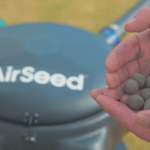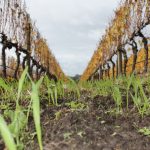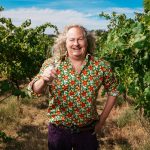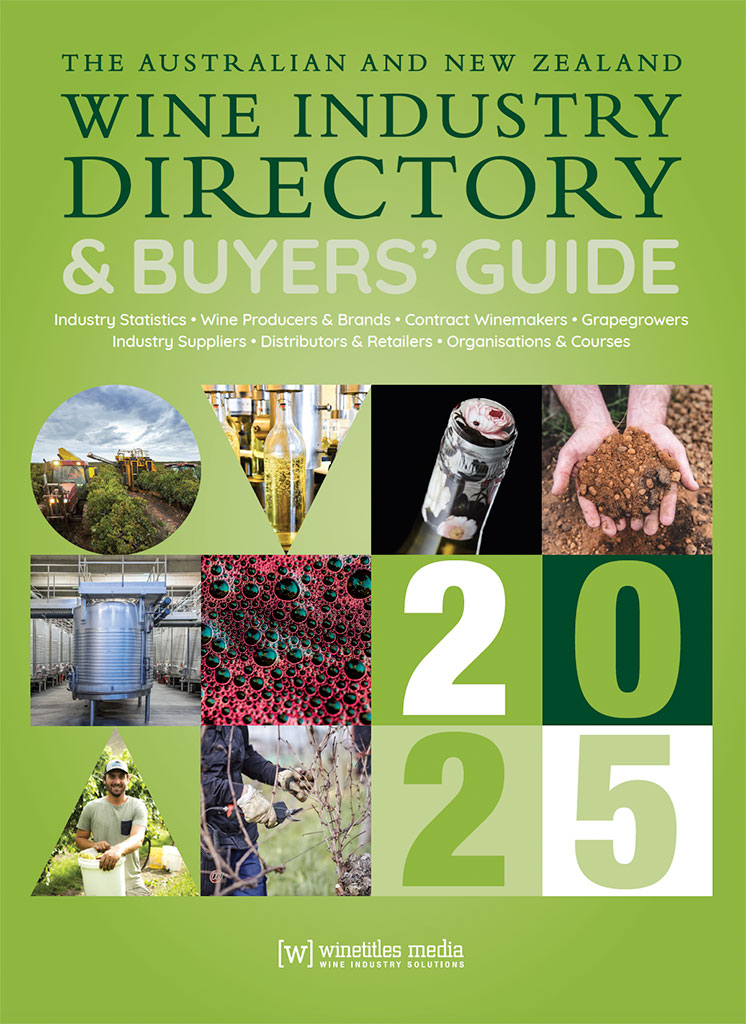By Greg Jarratt, Winemaker, St Huberts, Yarra Valley, Victoria
First published in the July/August 2017 issue of the Wine & Viticulture Journal
Owned by Treasury Wine Estates, St Huberts has notched up 30 years of growing Roussanne in its Yarra Valley vineyard
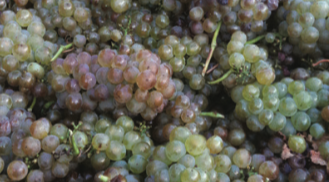
 Unlike many other ‘alternative’ varieties, Roussanne has had quite a history in Australia – a history in two parts. It probably first entered the country via one of the pioneers of our wine industry – James Busby. He catalogued cuttings of Roussanne taken from the “Hill of Hermitage” in 1833. The fate of these vines is a bit of a mystery, and I have a suspicion many were mixed into mid to late 1800s Marsanne blocks as fruit salad plantings. There is little doubt the variety’s white Rhone brethren Marsanne and Viognier became more popular and prolific over time. This is likely two-fold, given the latter varieties have more obvious fruit flavours, and importantly, tend to be better behaved in the vineyard. More on this later…
Unlike many other ‘alternative’ varieties, Roussanne has had quite a history in Australia – a history in two parts. It probably first entered the country via one of the pioneers of our wine industry – James Busby. He catalogued cuttings of Roussanne taken from the “Hill of Hermitage” in 1833. The fate of these vines is a bit of a mystery, and I have a suspicion many were mixed into mid to late 1800s Marsanne blocks as fruit salad plantings. There is little doubt the variety’s white Rhone brethren Marsanne and Viognier became more popular and prolific over time. This is likely two-fold, given the latter varieties have more obvious fruit flavours, and importantly, tend to be better behaved in the vineyard. More on this later…
The second part of Roussanne’s history started when the CSIRO obtained material from the Rhone Valley for its collection in 1974. The same clone entered South Australia in 1981, and it would seem Yeringberg, in the Yarra Valley, took some of the first cuttings and planted them in 1983. This clone is 1974/CX/ Vassal and occasionally referred to as the ‘Yeringberg clone’. Most of Australia’s older plantings of Roussanne are from this material and St Huberts 1.38ha block planted in 1987 is no exception. It has been established the original CSIRO Vassal clone contains the leafroll virus, and there are currently heat-treated versions of this clone, and ENTAV 468, available domestically.
The St Huberts vineyard is on the Yarra Valley floor, 80-100m above sea level – a warm site by Yarra standards. The soil is a quite well drained grey clay loam over a deeper clay layer, with rainfall around 750mm/annum. Roussanne is planted at 3.6m x 1.8m row and vine spacings in a north-south orientation and is VSP trained and two-bud spur pruned to 36-40 buds per vine. The vines were previously trellised to hanging cane, however around half the bunches tended to be overexposed and got too hot and sunburnt, leading to caramel characters and bitterness in the resultant wine.
As our Roussanne ripens mid to late season (typically harvested a week or two before our Cabernet Sauvignon), vineyard practices such as pruning and sprays are more in line with late reds. Prescription fertiliser blends are added at the start of each season across the vineyard based on soil tests every three years and specific deficiencies addressed though foliar sprays following annual petiole testing. The reasonably thin skins, medium to large size berries and quite tight bunches lead to a high risk of splitting and botrytis. With the Yarra’s high summer rainfall, vigilance and a diligent spray program are required. Vines are trimmed in December or January to help with airflow and maintain some exposure for the fruit.
Yields for the Roussanne block can be a feast or famine affair. It generally wants to throw too much fruit, so is crop thinned around set, sometimes closer to verasion. Previously, we aimed for crop levels around the 5-7t/ha, but in the last few years we’ve been getting better fruit quality closer to 8-10t/ha. Possibly the higher crop level slows down the rate of ripening and also allows for a larger picking window. In the last five years or so we have been hand picking around the 12- 12.5Bé mark. I emphasise hand picking, as on the one occasion we machine picked it resulted in bins full of ‘grape soup’ due to the thin skins, biggish berries and their low pulp contents. After quite a long period of relative ‘blah water bags’ tasting close to picking, flavour and spice does kick-in, but it seems after some time of low acidity in the fruit.
The new winemaking team in 2006 had no experience making wines from the variety, so we thought it best to do a vertical tasting over 10 vintages or so to identify the St Huberts ‘house style’. Three things became evident. First, there didn’t appear to be a clear ‘house style’. Some wines were oaky, some were sweet, some high alcohol and full, others tighter and lean (obviously a mix of vintage variation and the experimental footprints of our predecessors). Secondly, there were some pretty interesting tannins and phenolics going on. And, thirdly, the variety has the ability to age amazingly well!
So, with no real rule book, it was time to become familiar with this variety ourselves. Early on we treated it in a similar manner to Semillon, after all, it did look similar in the vineyard – apart from the rusty/bronzing on the exposed berries. We picked one parcel early and the other 10 days later, both crushed and pressed, a free run and pressings fraction separated, the early pick tank fermented and the late pick barrel fermented. Both had useful characters; the early pick (if tending a little neutral) had attractive floral aromatics, the latter, more richness and depth. The one thing that was restrained in both were the signature phenolics on the palate, hence those pressings had a part to play.
Today, with 10 years’ experience making Roussanne, and plenty of fun, we have pretty well settled on the style we are after for St Huberts, and how to aim for it each vintage. We are hunting the subtle floral notes, the fresh cut Nashi pear, and hints of citrus on the nose. For the palate, a fine and flinty wine with the underlying ‘slippery’, textural phenolics of the variety.
We keep our winemaking simple; hand pick, whole bunch press, no press cut (and often more than one hard press), full solids juice, an inoculated tank portion and a wild barrel ferment portion. The former gives freshness, aromatics and line to the wine, the latter in French oak a little more body and texture, and the 5% new oak a lift on the nose. It is typically blended, cleaned up and bottled in July/ August.
With much of the growth of wine sales in the domestic market coming from new products, growers, makers and marketers should always be thinking outside the box. ‘Emerging’ or ‘alternative’ varietals must certainly be in this mix.
REFERENCES
Ammerlaan, D. (2017) pers. comm.
de Pury, S. (2017) pers. comm.
Halliday, J. (2017) pers. comm.
Dry, N. (2017) pers. comm.
Murphy, P.D. (1992) National Register of Grapevine Varieties and Clones, Australian Vine Improvement Association.
Busby, J. (1833) Journal of a tour through some of the vineyards of Spain and France.
ROUSSANNE

By Peter Dry Emeritus Fellow, The Australian Wine Research Institute
BACKGROUND
Roussanne (roo-SAHN) originated in the northern Rhone but has spread to other parts of France. It was first mentioned in the late 18th century. Its name is said to derive from the French word roux in reference to the russet colour of its ripe berries. DNA e vidence has revealed a parent-offspring relationship with Marsanne. The global area planted in 2010 was 1746ha, close to 100% in France where the area has doubled since 2000. Synonyms include Barbin, Bergeron (Savoie), Fromental, Fromentau (Isere), Martin Cot (Savoie, Isere) and Petite Roussette (Hermitage). It is often blended with Marsanne in the still white wines of Hermitage, Crozes- Hermitage and Saint-Joseph; and in the still and sparkling wines of Saint-Péray. Roussanne is also permitted in the white wines of Chateauneuf-du-Pape and Cotes du Rhône and recommended in Languedoc, Roussillon, Provence, Loire and Savoie. There are small areas in Italy (Liguria, Tuscany), Portugal, Greece and USA (California, Oregon and Washington). Currently there are at least 64 wine producers in Australia, spread over more than 25 regions, mainly in Victoria and South Australia (25ha in 2015)—Barossa Valley, Canberra District, Yarra Valley and Rutherglen have the most producers.
VITICULTURE
Roussanne is reputed to be a difficult variety to grow. Budburst is mid-season and maturity is mid-season to late (relatively late for a white variety). Vigour is low with an erect growth habit. Bunches are small to medium and well-filled with small berries. Yield is relatively low and irregular. Spur pruning is most often used in Australia. It is very susceptible to Oidium, Botrytis bunch rot and wind damage. Although bunches are sensitive to sunburn, some exposure is said to be necessary to ensure even ripening.
WINE
Roussanne wines are medium- to full-bodied with crisp acidity and finesse. A textural palate is a common feature irrespective of source. Descriptors include ‘peach’, ‘quince’, ‘apricot blossom’, ‘lime peel’ and ‘savoury’. With age, wines can develop ‘honey’ and ‘butterscotch’ characters. It is mainly used for varietal wines in Australia but can also be a useful blending partner with Marsanne and Viognier.

